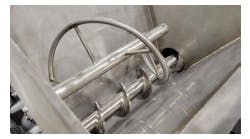Four technology strategies every process manufacturer should consider in a post-pandemic world
While the COVID-19 pandemic affected virtually every industry in 2020, it hit manufacturing harder than most. According to a survey, nearly 80% of industrial manufacturers said they expected the COVID-19 pandemic to significantly impact their business. This is much higher than the 48% of respondents from a mix of other industries reported.
This challenge has accelerated the need for the new digital strategies, technologies and solutions to help process manufacturers quickly achieve business continuity and position their company for success in a post-pandemic world. While many process manufacturers were probably already in the process of evaluating or even implementing new digital tools in early 2020, it is also highly likely that the majority simply didn’t have time to complete this effort.
Where process manufacturers once had the luxury of planning their digital transformation over a three-to-five-year timeframe, the sudden onslaught of COVID-19 now meant they needed completely new strategies — in just a few short months. Process manufacturers suddenly needed new ways to reduce waste, enable production to keep up with spikes in demand and gain remote visibility into their supply chain and other aspects of their business.
Many process manufacturing leaders quickly developed creative ideas to successfully fend off the initial challenges caused by the pandemic. Yet chances are good that these companies are still looking to adopt new approaches to provide business advantages in the near future.
At Stratus Technologies, these are exactly the types of conversations we are currently having with our process manufacturing customers. We have found that many of these discussions consistently uncover a few common topics, so if your organization is looking for best practices to accelerate your digital transformation strategy in a post-pandemic world, we recommend considering the four strategies below.
1. Prevent downtime with proven high availability
A process manufacturer’s bottom line depends on its ability to keep its infrastructure, systems, applications and machinery up and running at all times. No matter how slight, any downtime can lead to lower yields, inferior product quality, missed deadlines, compliance fines and unhappy customers. All these factors have a real financial impact: lower asset ROI, revenues and profits.
To avoid these consequences, process manufacturers require continuous availability and failure-prevention compute platforms supporting IT, OT and a wide variety of other applications. Specifically, manufacturing organizations should deploy redundant computing platforms, so if one node fails, the backup takes over immediately. Many process manufacturers would also be wise to select rugged, industrial-grade servers capable of operating in harsh plant environments.
As process manufacturers consider the right computing platform, they should look for technology that supports fault-tolerant and/or high availability workloads, failure recovery, CPU restart, self-checking, machine diagnostics and health alerts indicating potential issues before something fails.
2. Reduce risk from a distance: remote monitoring and controls
The remote workforce concept is here to stay, and process manufacturers will continue to support this model to comply with any future quarantine mandates, but also to promote employee safety, morale and even retention. Yet it is a difficult balancing act in an industry where workers are so vital in keeping busy manufacturing lines running at peak efficiency and production on target. It can be even more challenging when something goes wrong — or systems stop running.
Consider the case of a pharmaceutical processor producing a new lot of pills. In the current situation — where there are now fewer employees on the floor — if something happens, the company may have a hard time uncovering troubleshooting, investigating time logs and determining what can be salvaged. The pharmaceutical processor may also have a hard time implementing track-and-trace capabilities, which could lead to high levels of scrap, or even the need to completely discard the entire batch. Such a scenario leads to extremely high unplanned costs, which can be made worse since track-and-trace capabilities may be mandated by industry regulations, potentially resulting in compliance fines.
Process manufacturers can now implement health alerts and controls to provide real-time visibility and actionable steps needed to resolve potential issues in a timely manner. For example, these systems can alert remote operators when something goes wrong — or exceeds a predetermined threshold — so they can quickly uncover all the important details and take the right action to resolve the issue.
3. Close the IT-OT gap with easy-to-manage technology
In most process manufacturing environments, the computing platform supports those systems traditionally owned and operated by both IT and OT. Yet OT staff are usually responsible for managing, maintaining and troubleshooting these mission-critical systems, especially if IT resources are off-site or travel to multiple facilities.
OT employees are more likely to wear hard hats and steel-toed boots than button-down shirts and are incredibly adept at managing specialized manufacturing equipment and control systems such as programmable logic controllers (PLCs), SCADA systems, distributed control systems (DCS) and other infrastructure. They are different from their IT counterparts and are proficient in deploying new applications, managing existing systems and doing all they can to make sure everything runs as expected and as designed with all other parts of the process.
Chances are good that OT teams were already stretched too thin before the COVID-19 pandemic, but now, with so many employees working remotely, the same number of OT staff are no longer on site. This puts even more emphasis on system uptime and redundant architectures (as described above), but this situation also highlights the very real need for computing platforms to be as easy as possible to install, configure, deploy and maintain. In today’s COVID-19 world, the idea of flying someone in from IT to fix a problem may not be an option anymore. It is much more appealing to implement OT-friendly technology that requires minimal effort to troubleshoot or even replace.
4. Take advantage of innovative new technologies
Process manufacturers are continuing to evaluate the potential of innovative technologies such as IIoT, artificial intelligence, machine learning and even virtual reality/augmented reality. Their benefits are well-established and well-documented. These technologies are already driving real improvements in important areas such as big data analytics for improved decision making and predictive maintenance to keep machinery running and reduce related costs.
For example, consider the potential behind augmented reality (AR). Instead of asking employees to bring heavy, outdated technology to diagnose an issue — and potentially subjecting them to safety concerns — augmented reality can give technicians the information they need to assess a problem or perform a maintenance task. AR devices can help make it easier for technicians to do their jobs. They also reduce the need to have multiple people working in the same space and enhance worker health and safety.
Additionally, IIoT-enabled devices, such as sensors and PLCs, improve manufacturing processes when combined with monitoring and control software. This combination enables real-time data to be converted into actionable insights with very little human interaction.
It is essential to pick the right platform to enable and support these technologies. Edge computing — a distributed information architecture that collects and processes data at the furthest point, or “edge” of a computer network — is the ideal platform for process manufacturers. Edge computing can minimize downtime, reduce latency, improve bandwidth utilization and facilitate access to mission-critical data. This enhances decision-making speed and outcomes that are so vital to any business. High availability edge computing is also a key part of any digital transformation strategy since it provides mission-critical data needed for IIoT, data analytics, predictive maintenance, AR/VR and so many other digital use cases.
Develop the right plan now
This is the time of year where we all tend to look at ahead and consider new ways to improve. However, due to the unexpected challenges related to COVID-19, the start of 2021 is unprecedented. Forward-thinking is more critical for process manufacturing leaders than ever before. To overcome the challenges of COVID-19, process manufacturers must quickly evaluate and roll out the right strategies and supporting technologies and continue to transform their business.
By following the four strategies outlined above — preventing downtime, embracing remote monitoring systems and controls, deploying OT-friendly systems and taking full advantage of innovative new technologies — process manufacturers can gain a critical advantage over the competition and best position their business for immediate success in a post-pandemic world and beyond.
Aric Prost is the Senior Director of Business Development at Stratus Technologies. Learn more at www.stratus.com.


